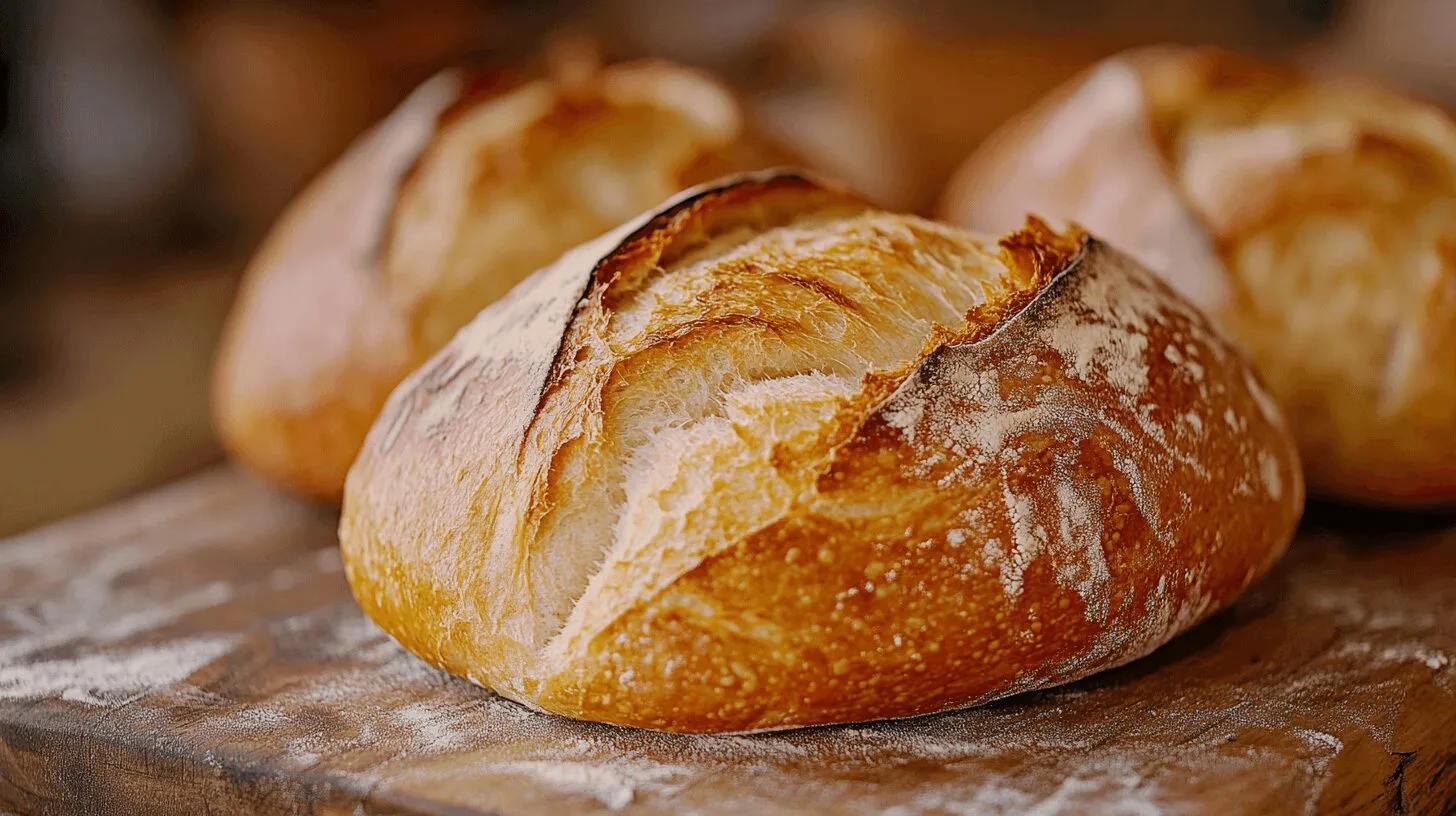Cuban bread recipe is a staple in Cuban cuisine, known for its crispy crust and soft, airy interior. Whether you’re making a classic Cuban sandwich (Cubano) or enjoying it warm with butter and coffee, mastering the art of making Cuban bread recipe at home is a rewarding experience.
In this guide, we’ll dive deep into the origins, ingredients, step-by-step instructions, and expert tips to help you bake the perfect loaf. Let’s start by understanding what makes Cuban bread recipe unique and why it’s beloved by so many!
Cuban Bread Recipe: What Is Cuban Bread?
Cuban bread is a light and fluffy white bread with a distinctive thin, crisp crust. It’s an essential part of Cuban cuisine, commonly used for making tostadas (buttered toast), pan con lechón (pork sandwiches), and Cubanos (Cuban sandwiches).
But what makes Cuban bread different from other types of bread? Let’s take a look at its history and defining characteristics.
A Brief History of Cuban Bread
Although associated with Cuban culture, traditional Cuban bread as we know it today actually became popular in Tampa, Florida, where Cuban immigrants settled in the late 19th century.
- Origins in Tampa, Florida – The Ybor City district became a hub for Cuban bakers, where Cuban bread became a staple for cigar workers.
- Cuban-American Influence – While bread was a common food in Cuba, the version baked in Florida became the gold standard due to its unique baking methods.
- Traditional Palmetto Leaf Topping – Many Cuban bread loaves are baked with a strip of palmetto leaf on top, which helps create a signature split in the crust.
Today, Cuban bread is widely enjoyed in Cuban communities across Miami, Tampa, and beyond.
What Makes Cuban Bread Recipe Different?
Cuban bread may look similar to French or Italian bread, but it has distinct qualities that set it apart.
| Feature | Cuban Bread | French Bread | Italian Bread |
|---|---|---|---|
| Crust | Thin, crisp | Thick, chewy | Medium crust |
| Interior | Soft, airy, fluffy | Slightly dense | Soft, but not as airy |
| Fat Content | Uses lard or shortening | No fat added | Uses olive oil or butter |
| Shape | Long, narrow loaves | Baguette-style | Round or oval loaves |
| Flavor | Mildly sweet, rich | Slightly tangy | Neutral, mild flavor |
Key Characteristics of Authentic Cuban Bread
✔ Made with lard or vegetable shortening for richness
✔ Thin, crispy crust (not thick and chewy like French bread)
✔ Light and airy interior
✔ Baked with steam to enhance crispiness
✔ Traditionally baked with a palmetto leaf on top
Unlike French baguettes, which have a chewy crust, Cuban bread recipe is known for its light, crackly crust that shatters when you take a bite.
Why Cuban Bread Is So Popular
Cuban bread isn’t just a staple in Cuban cuisine—it’s also a key ingredient in Cuban-American food culture. Here’s why:
- Perfect for Cuban Sandwiches (Cubanos) – The bread’s soft texture and crispy crust make it ideal for pressing sandwiches.
- Pairs Well with Butter and Coffee – In Cuban households, “tostada con café” (toasted Cuban bread with coffee) is a beloved breakfast tradition.
- Light, Yet Flavorful – Unlike dense breads, Cuban bread is airy, soft, and easy to eat.
Essential Ingredients for Cuban Bread Recipe
Now that we understand what makes Cuban bread recipe unique, let’s take a closer look at the key ingredients that give it its signature texture and flavor.
Unlike other types of bread, Cuban bread recipe relies on a few simple ingredients, but the way they are combined and processed makes all the difference.
What Are the Ingredients in Cuban Bread Recipe?
To make authentic Cuban bread, you’ll need just a handful of pantry staples.
Cuban Bread Recipe Essential Ingredients
| Ingredient | Purpose in Cuban Bread |
|---|---|
| Bread Flour | Provides structure and elasticity |
| Water | Activates the yeast and hydrates the dough |
| Active Dry Yeast | Helps the bread rise and creates air pockets |
| Sugar | Adds a mild sweetness and feeds the yeast |
| Salt | Enhances flavor and strengthens gluten |
| Lard or Butter | Adds richness, softness, and a slight savory taste |
These ingredients work together to create the light, airy crumb and thin, crispy crust that make Cuban bread so delicious.
Ingredient Breakdown
1. Bread Flour vs. All-Purpose Flour: Which One to Use?
- Bread flour is recommended because it has higher protein content (11-13%), which creates stronger gluten formation and improves the chewiness and rise.
- All-purpose flour can be used, but the bread may turn out slightly less airy and more delicate.
2. The Role of Yeast in Cuban Bread
Yeast is crucial for achieving the signature airy texture of Cuban bread.
- Use active dry yeast or instant yeast.
- If using fresh yeast, you may need to double the quantity.
- Yeast should be activated in warm water (about 100°F/38°C) with sugar before adding to the flour.
3. Why Lard (or Butter) Is Important
- Lard is the traditional fat used in Cuban bread. It enhances flavor, softness, and richness.
- If you prefer a vegetarian alternative, use unsalted butter or vegetable shortening instead.
- Olive oil can be used, but it may slightly alter the flavor.
4. Sugar: The Secret to Cuban Bread’s Mild Sweetness
- Cuban bread is not as sweet as brioche, but the sugar helps balance the flavors.
- White sugar is traditional, but honey or agave syrup can be used for a slight variation.
5. The Importance of Salt
Salt does more than add flavor—it also controls yeast growth and strengthens the gluten structure. Without it, the bread could rise too quickly and collapse.
Ingredient Substitutions and Variations
If you want to tweak the recipe slightly, here are some common ingredient swaps:
| Traditional Ingredient | Alternative Option | Effect on Bread |
|---|---|---|
| Bread Flour | All-Purpose Flour | Slightly less chewy, more delicate |
| Lard | Butter | Similar texture, slightly richer flavor |
| Lard | Olive Oil | Softer crust, subtle olive flavor |
| White Sugar | Honey | Slightly more moisture and a hint of floral sweetness |
| Active Dry Yeast | Instant Yeast | Faster rise, no need to proof yeast |
What Kind of Water Should You Use?
Believe it or not, the type of water can affect the texture of your bread!
✔ Use lukewarm water (about 100°F or 38°C) – This helps activate the yeast properly.
✔ Avoid distilled or overly filtered water – Yeast thrives best in natural minerals.
✔ Hard water vs. Soft water? – Hard water (with more minerals) can strengthen gluten, while soft water may require extra kneading.
Step-by-Step Cuban Bread Recipe
Now that we’ve covered the essential ingredients, it’s time to put them to use! In this section, we’ll go step by step through the process of making authentic Cuban bread, from preparing the dough to baking it to perfection.
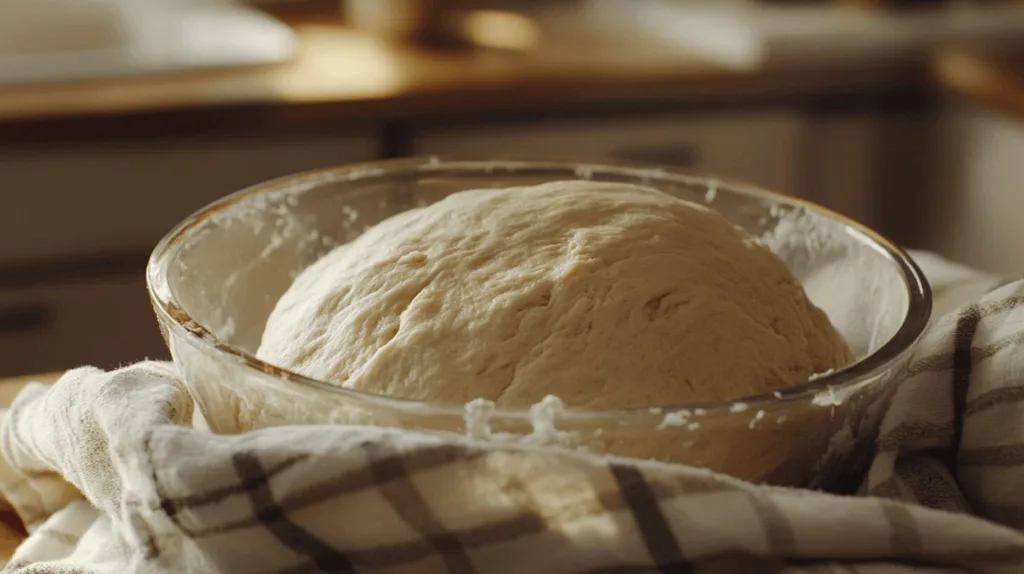
By following these detailed instructions, you’ll get a crispy crust, airy texture, and delicious flavor—just like traditional Cuban bakeries.
Step 1: Preparing the Dough
Ingredients You’ll Need:
✅ 4 cups bread flour (or all-purpose flour)
✅ 1 ½ cups warm water (about 100°F/38°C)
✅ 2 ¼ teaspoons (1 packet) active dry yeast
✅ 2 tablespoons sugar
✅ 1 ½ teaspoons salt
✅ 2 tablespoons lard or unsalted butter (melted)
Instructions:
1. Activate the Yeast
- In a small bowl, combine warm water, sugar, and yeast.
- Stir gently and let it sit for 5–10 minutes until foamy. (If no foam appears, your yeast may be expired or your water was too hot.)
2. Mix the Dough
- In a large mixing bowl, combine flour and salt.
- Pour in the yeast mixture and melted lard (or butter).
- Mix with a wooden spoon until a sticky dough forms.
3. Knead the Dough
- Transfer the dough to a lightly floured surface.
- Knead by hand for 10–12 minutes (or 5–6 minutes in a stand mixer) until the dough is smooth and elastic.
- The dough should be slightly tacky but not overly sticky.
Pro Tip: If the dough is too dry, add 1 tablespoon of water at a time. If it’s too sticky, sprinkle a little flour.
Step 2: First Rise (Fermentation)
- Lightly grease a large bowl and place the dough inside.
- Cover with a damp kitchen towel or plastic wrap.
- Let it rise in a warm place for 60–90 minutes, or until doubled in size.
✔ Ideal Rising Temperature: 75–80°F (24–27°C).
✔ If your kitchen is cold, place the bowl in a slightly warmed oven (turned off) or near a sunny window.
Step 3: Shaping the Loaves
- Once the dough has doubled in size, punch it down to release air bubbles.
- Transfer it to a lightly floured surface.
- Divide it into two equal portions.
- Roll each portion into a long, oval loaf (about 12 inches long and 3 inches wide).
✔ Traditional Cuban bread is shaped like a submarine roll, not round like Italian bread.
Step 4: Second Rise (Proofing)
- Place the shaped loaves on a parchment-lined baking sheet.
- If you have a palmetto leaf, place one on top of each loaf.
- Cover loosely with a towel and let them rise for another 30 minutes.
Step 5: Baking Cuban Bread
How to Bake for the Perfect Crust & Texture
- Preheat oven to 400°F (200°C).
- Place a shallow baking dish filled with hot water on the bottom rack (this creates steam for a crispy crust).
- Lightly spray or brush the loaves with water before baking.
- Bake for 20–25 minutes, or until golden brown and crispy.
✔ If you want an extra crispy crust, spray the loaves with water again halfway through baking.
Step 6: Cooling & Storing
- Remove from the oven and let the bread cool on a wire rack for at least 15 minutes before slicing.
- For best texture, eat within 24 hours.
✔ Store at room temperature in a paper bag for up to 2 days.
✔ To keep longer, wrap in plastic and freeze for up to 3 months.
Tips for Perfect Cuban Bread
Now that you’ve mastered the step-by-step process of making Cuban bread, let’s explore some pro tips to ensure your loaves turn out crispy, fluffy, and flavorful every time.
Baking is both a science and an art, and small tweaks can make a huge difference in your final result. These expert tips will help you achieve that authentic Cuban bread texture—crispy on the outside, light and airy on the inside.
How to Get the Perfect Crispy Crust
A thin, crackly crust is one of the defining features of authentic Cuban bread. Here’s how to achieve it:
1. Use Steam in the Oven
- Place a shallow pan of boiling water on the bottom rack of the oven while baking.
- The steam helps keep the crust crisp while the inside stays soft.
- Some bakers even spray water into the oven during the first 10 minutes to enhance steam.
2. Brush with Water Before Baking
- Lightly mist or brush the loaves with water before placing them in the oven.
- This keeps the dough’s surface moist, preventing it from hardening too quickly.
3. Bake at High Temperature
- 400°F (200°C) is the ideal temperature for Cuban bread.
- Lower temperatures will soften the crust, while too high of a temperature can cause burning without fully baking the inside.
How to Make Cuban Bread Soft and Fluffy Inside
While the crust is crispy, the inside should be light and airy. Follow these tips to get that perfect balance:
1. Knead the Dough Well
- Kneading develops gluten, which gives the bread its chewy, elastic texture.
- Knead for 10–12 minutes by hand or 5–6 minutes in a stand mixer.
- A properly kneaded dough should stretch without tearing.
2. Allow Enough Rising Time
- If your bread doesn’t rise properly, it will be dense and heavy.
- Let the dough double in size during the first rise (about 60–90 minutes).
- Allow a second rise of at least 30 minutes after shaping the loaves.
3. Don’t Use Too Much Flour
- If your dough is too dry, it won’t expand properly.
- The dough should feel slightly sticky but still easy to handle.
- If it’s too dry, add 1 tablespoon of water at a time while kneading.
Why Does My Cuban Bread Flatten Instead of Rising?
Flattened bread can be frustrating! Here’s what might be going wrong:
| Problem | Solution |
|---|---|
| Dough is too wet | Add a little more flour, 1 tablespoon at a time. |
| Not enough kneading | Knead longer to build strong gluten structure. |
| Over-proofing | Don’t let it rise too long—90 minutes max for the first rise. |
| Yeast is old or inactive | Always check yeast freshness before using. |
| Oven is too cold | Preheat oven properly to 400°F (200°C). |
| No steam in the oven | Add a pan of hot water while baking. |
How to Store and Reheat Cuban Bread
Cuban bread is best enjoyed fresh, but if you have leftovers, here’s how to keep it fresh longer.
Best Way to Store Cuban Bread
- Short-term storage (1–2 days): Keep in a paper bag at room temperature.
- Longer storage (3–5 days): Wrap in plastic wrap or foil and keep in an airtight container.
- Freezing: Wrap in plastic, then foil, and freeze for up to 3 months.
How to Reheat for Freshness
- Oven: Wrap the bread in foil and warm at 350°F (175°C) for 5–7 minutes.
- Toaster: Slice and toast for a crispy finish.
- Microwave (not recommended): This makes the bread chewy and rubbery.
Cuban Bread vs. Other Breads – What Makes It Unique?
Cuban bread has a distinct texture and flavor, but how does it compare to other types of bread? Many people wonder if they can substitute Cuban bread with something similar or if there’s a big difference between Cuban, Puerto Rican, and French bread.
In this section, we’ll break down what makes Cuban bread unique and explore the closest alternatives you can use if Cuban bread isn’t available.
What Kind of Bread Is Closest to Cuban Bread?
While Cuban bread has its own unique characteristics, there are a few close substitutes that can be used when needed. Let’s compare them:
| Bread Type | Crust | Interior Texture | Fat Content | Best Used For |
|---|---|---|---|---|
| Cuban Bread | Thin, crispy | Soft, airy, fluffy | Contains lard or butter | Cuban sandwiches, tostadas, pan con lechón |
| French Bread (Baguette) | Thick, chewy | Slightly denser | No added fat | Soups, sandwiches |
| Italian Bread | Medium crust | Soft and slightly chewy | Uses olive oil or butter | Bruschetta, panini |
| Puerto Rican Bread (Pan de Agua) | Softer crust | Moist and fluffy | No added fat | Sandwiches, breakfast bread |
| Bolillo (Mexican Bread) | Medium-thick crust | Soft inside | No added fat | Torta sandwiches |
| Ciabatta | Thick, crispy | Very airy, open crumb | Contains olive oil | Panini, dipping bread |
✔ Best Substitute for Cuban Bread: French bread or Italian bread can work, but they have a chewier crust and lack the softness of Cuban bread. Puerto Rican Pan de Agua is the closest match in terms of texture and taste.
What’s the Difference Between Puerto Rican Bread and Cuban Bread?
Many people confuse Cuban bread and Puerto Rican Pan de Agua, but there are key differences between the two.
| Feature | Cuban Bread | Puerto Rican Bread (Pan de Agua) |
|---|---|---|
| Crust | Thin and crispy | Softer crust |
| Interior | Light and airy | Soft and slightly more moist |
| Fat Content | Contains lard or butter | No fat added |
| Best Use | Cuban sandwiches, tostadas | Breakfast toast, daily bread |
✔ The biggest difference? Cuban bread is crispier and has a richer taste due to lard, while Puerto Rican bread is softer and more neutral in flavor.
Why Cuban Bread Is the Best Choice for Cuban Sandwiches
If you’ve ever had a Cuban sandwich (Cubano), you know that the bread makes all the difference! Cuban bread is the only bread that gives the sandwich its crispy exterior while staying soft inside.
What Happens if You Use the Wrong Bread?
❌ French baguettes are too chewy – They don’t press well and can be hard to bite into.
❌ Italian bread is too soft – It soaks up juices too quickly and loses structure.
❌ Ciabatta has too many holes – The airy texture doesn’t hold fillings well.
✔ Cuban bread is perfect because it crisps up beautifully when pressed while staying soft enough to absorb the flavors!
What Is the Most Delicious Bread in the World?
Bread is loved worldwide, and while Cuban bread is a favorite, many cultures have their own famous bread varieties. Here are some of the most delicious breads around the world:
Top 5 Most Delicious Breads Globally
1️⃣ Cuban Bread (Crispy outside, soft inside – perfect for sandwiches)
2️⃣ French Baguette (Iconic crusty bread, great with butter and cheese)
3️⃣ Italian Ciabatta (Light, airy, perfect for paninis)
4️⃣ Indian Naan (Soft, chewy, often served with curry)
5️⃣ Sourdough Bread (Tangy, chewy, naturally fermented)
Each bread has its own unique flavor and purpose, but Cuban bread stands out for its versatility and delicate balance of crispiness and softness.
Why Cuban Bread Tastes So Good
Cuban bread has a simple list of ingredients, but its flavor is anything but ordinary. It has the perfect balance of crispiness, softness, and a mild sweetness that makes it irresistible. But what exactly makes Cuban bread taste so good?
In this section, we’ll break down the science of flavor, the role of traditional ingredients, and the baking techniques that give Cuban bread its unique taste.
Why Does Cuban Bread Taste So Good?
Several factors contribute to the delicious taste of Cuban bread, including:
1. The Use of Lard for Richness
✔ Lard is the secret ingredient in Cuban bread. Unlike most bread, which uses butter or oil, Cuban bread is traditionally made with lard, which adds:
- A slightly savory depth to the bread’s flavor.
- A softer, more tender crumb.
- A richer taste than bread made with just flour, water, and yeast.
Can You Make Cuban Bread Without Lard?
Yes! You can substitute lard with butter or vegetable shortening, but the flavor and texture will be slightly different.
2. A Touch of Sugar for Subtle Sweetness
✔ Unlike French or Italian bread, Cuban bread contains a small amount of sugar, which:
- Helps the yeast activate and ferment.
- Adds a hint of sweetness that balances the saltiness.
- Promotes a golden crust by caramelizing during baking.
✔ The sweetness is not overpowering—it just enhances the natural flavor of the bread.
3. A Light, Airy Texture That Melts in Your Mouth
✔ Cuban bread is known for its soft, fluffy interior, which is achieved by:
- Using high-protein bread flour for better gluten development.
- Kneading the dough well to create elasticity.
- Letting it rise twice to build air pockets and lightness.
Why is Cuban bread so soft inside?
The addition of lard or butter coats the gluten strands, making them more flexible and preventing the bread from becoming too chewy.
4. The Crispy, Crackly Crust
✔ Cuban bread has a thin, delicate crust that is:
- Crispier than Italian bread
- Thinner than a French baguette
- Crackly, not chewy
✔ This is achieved by:
- Baking with steam to create a crisp crust.
- Brushing the bread with water before baking.
- Using high heat (400°F) to encourage rapid crust formation.
Why Is Cuban Bread So Addictive?
Cuban bread is so good that people can’t stop eating it! Here’s why:
✔ The crunchy outside + soft, warm inside creates the perfect bite.
✔ It absorbs butter, garlic, and sauces beautifully.
✔ It pairs perfectly with Cuban coffee, sandwiches, and soups.
Many Cuban bakeries sell warm loaves early in the morning, and it’s common for customers to rip off a piece before they even get home!
Storing and Reheating Cuban Bread
Cuban bread is best enjoyed fresh, straight out of the oven. However, if you have leftovers, it’s important to store and reheat it properly to maintain its crispy crust and soft interior.
Unlike some other breads, Cuban bread tends to stale quickly due to its simple ingredients and lack of preservatives. But don’t worry—if stored correctly, you can still enjoy it for several days!
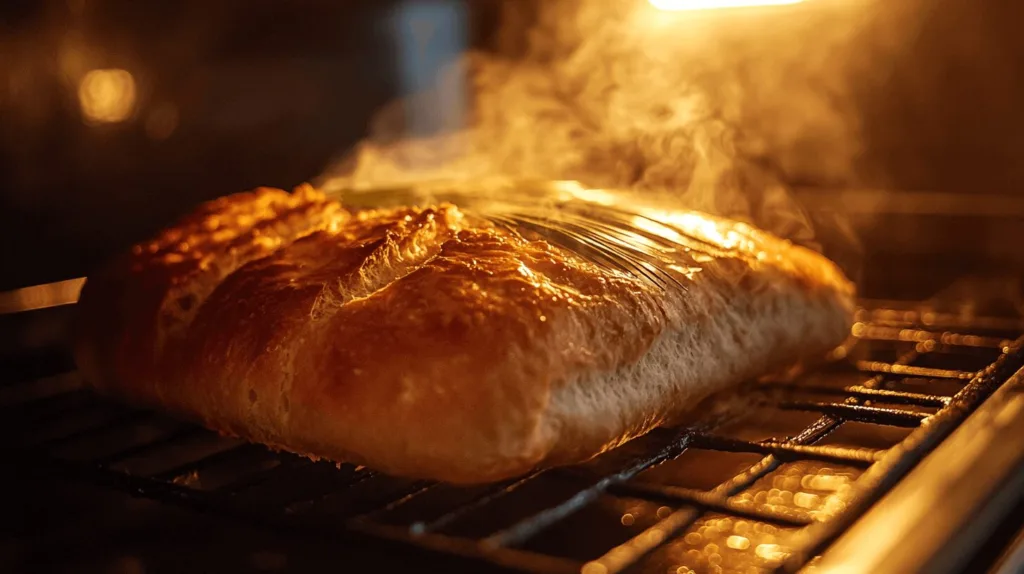
How to Store Cuban Bread Properly
To keep your Cuban bread fresh and delicious, follow these storage methods based on how long you plan to keep it.
1. Short-Term Storage (1–2 Days)
✔ Keep the bread in a paper bag at room temperature.
✔ Store it in a cool, dry place, away from moisture.
✔ Avoid plastic bags—they trap moisture and make the crust soggy.
Why use a paper bag?
It allows air circulation, which prevents the crust from softening too quickly while keeping the inside moist.
2. Medium-Term Storage (3–5 Days)
✔ Wrap the bread in foil or a clean kitchen towel.
✔ Place it in a bread box or an airtight container.
✔ If your kitchen is humid, add a dry paper towel inside the container to absorb excess moisture.
3. Freezing Cuban Bread (Up to 3 Months)
If you want to store Cuban bread for a longer period, freezing is the best option.
How to Freeze Cuban Bread:
1️⃣ Let the bread cool completely.
2️⃣ Wrap it tightly in plastic wrap, then in foil.
3️⃣ Place it in a freezer-safe bag, removing as much air as possible.
4️⃣ Label the bag with the date to keep track of freshness.
✔ Tip: Freeze the bread whole or sliced. Sliced bread is easier to reheat because you can take out only what you need.
How to Reheat Cuban Bread for Maximum Freshness
Cuban bread tastes best when warmed up properly. Here’s how to restore its crispy crust and soft interior.
1. Oven Method (Best for Whole Loaves)
✔ Preheat oven to 350°F (175°C).
✔ Wrap the bread loosely in foil.
✔ Bake for 5–10 minutes, depending on size.
✔ Remove the foil for the last 2 minutes to crisp up the crust.
Why does this work?
The foil traps moisture inside, keeping the bread from drying out, while the final uncovered baking restores the crispy crust.
2. Toaster or Air Fryer Method (Best for Slices)
✔ Place slices in a toaster or air fryer at 350°F (175°C).
✔ Toast for 2–3 minutes until warm and crispy.
✔ Add butter for extra flavor!
3. Skillet Method (Best for Making Tostadas)
✔ Heat a dry skillet over medium heat.
✔ Place slices cut-side down and toast for 1–2 minutes per side.
✔ For extra crispiness, brush with butter or olive oil before toasting.
4. Microwave Method (Not Recommended, But Works in a Pinch)
If you’re in a hurry, the microwave can soften Cuban bread but won’t restore its crispiness.
✔ Wrap the bread in a damp paper towel.
✔ Microwave for 10–15 seconds.
✔ Toast briefly in a skillet or toaster to crisp up the crust.
Note: Microwaving alone will make the bread chewy and rubbery. Always re-toast after microwaving for the best texture.
How to Keep Reheated Cuban Bread from Drying Out
✔ Never reheat at high heat for too long—this will dry out the bread.
✔ Wrap the bread in foil when using the oven to lock in moisture.
✔ If the bread feels too dry, brush it with a little water before reheating to add steam.
Cuban Bread Around the World
Cuban bread is deeply rooted in Cuban and Cuban-American culture, but its influence extends far beyond Cuba and Florida. People around the world enjoy this delicious bread in different ways, incorporating it into their local cuisines and daily traditions.
In this section, we’ll explore how Cuban bread is enjoyed globally, how it compares to other international breads, and the best places to find authentic Cuban bread outside of Cuba.
How Cuban Bread Is Enjoyed in Different Cultures
While Cuban bread originated in Tampa, Florida, it has become a favorite in many countries. Here’s how people enjoy it worldwide:
🇨🇺 Cuba: A Daily Staple with Coffee
✔ Breakfast Tradition – In Cuba, bread is often buttered and toasted (called a tostada) and served with strong Cuban coffee (cafecito).
✔ Served with Cuban Dishes – Cuban bread is used to soak up sauces from dishes like ropa vieja (shredded beef) and picadillo (ground beef stew).
🇺🇸 USA: The Heart of Cuban Sandwich Culture
✔ Florida’s Cuban Bread Capital – Tampa and Miami are home to some of the best Cuban bakeries in the U.S.
✔ Used for Cubanos (Cuban Sandwiches) – Layered with roast pork, ham, Swiss cheese, pickles, and mustard, then pressed to perfection.
✔ Garlic Bread Variation – Many restaurants serve buttery, garlic Cuban bread as a side dish.
🇵🇷 Puerto Rico: Pan Sobao & Pan de Agua
✔ Puerto Rican bakeries make similar breads like Pan Sobao (sweet soft bread) and Pan de Agua (water bread).
✔ Though slightly different, Pan de Agua is often used as a Cuban bread substitute.
🇪🇸 Spain: Similar Textures in Traditional Breads
✔ Spanish barra de pan (a softer version of a baguette) shares similarities with Cuban bread.
✔ In Spain, toasted bread with tomato (pan con tomate) is a popular breakfast dish that resembles Cuban tostadas.
🇲🇽 Mexico: A Close Cousin to Bolillo Bread
✔ Bolillo and Telera rolls have a similar crust and texture to Cuban bread but are slightly denser.
✔ Used in tortas (Mexican sandwiches), just as Cuban bread is used in Cubanos.
Where to Find Authentic Cuban Bread Outside of Cuba
If you’re not in Cuba, Miami, or Tampa, you might have a hard time finding real Cuban bread. However, here are some places where you can buy or make it:
✔ Cuban Bakeries in Florida – The best Cuban bread comes from La Segunda Bakery (Tampa) and Versailles Bakery (Miami).
✔ Latino Supermarkets – Stores like Sedano’s, Publix (Florida locations), and specialty Latin grocery stores often carry Cuban bread.
✔ Online Bakeries – Some Cuban bakeries ship nationwide in the U.S.
✔ Homemade – The best way to enjoy Cuban bread outside of Florida is to bake it yourself using an authentic recipe!
How Cuban Bread Compares to Other International Breads
Cuban bread shares similarities with some other famous breads, but each has its own unique qualities.
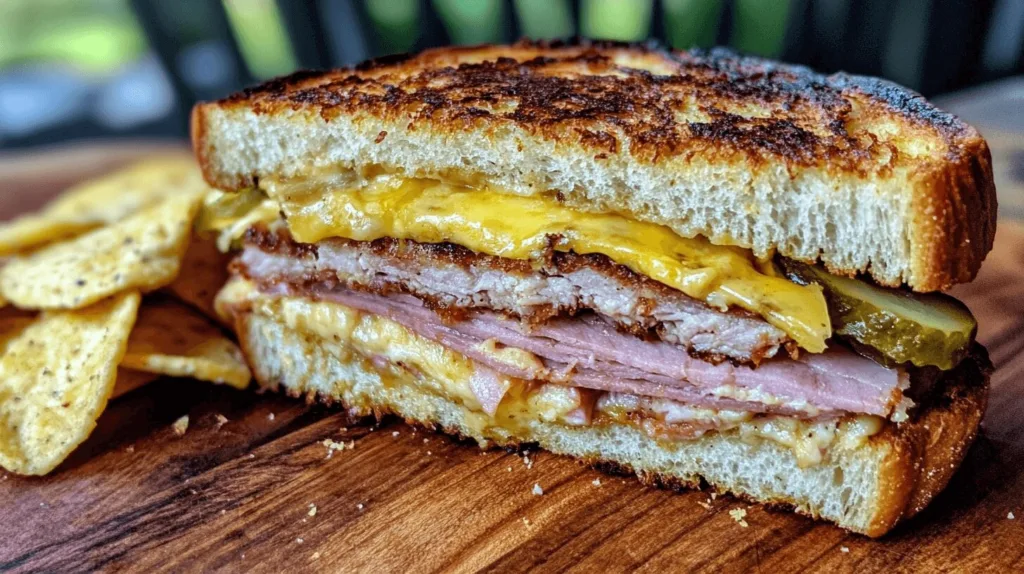
| Bread Type | Country | Crust | Interior Texture | Best Used For |
|---|---|---|---|---|
| Cuban Bread | 🇨🇺 Cuba / USA | Thin, crispy | Soft, airy, fluffy | Cuban sandwiches, breakfast tostadas |
| French Baguette | 🇫🇷 France | Thick, chewy | Slightly dense | Served with cheese, soups, sandwiches |
| Italian Ciabatta | 🇮🇹 Italy | Crispy, airy | Open crumb, chewy | Paninis, dipping in olive oil |
| Puerto Rican Pan de Agua | 🇵🇷 Puerto Rico | Softer crust | Moist and fluffy | Sandwiches, breakfast toast |
| Mexican Bolillo | 🇲🇽 Mexico | Medium-thick crust | Soft inside | Tortas, sandwiches |
✔ Cuban bread is unique because of its thin, crisp crust and airy softness, making it the best option for pressed sandwiches like the Cubano.
FAQ – Everything You Need to Know About Cuban Bread Recipe
Before we wrap up this ultimate guide, let’s answer some of the most common questions people have about Cuban bread. Whether you’re curious about its ingredients, substitutes, or history, this FAQ section has you covered!
Cuban bread stands out because of its thin, crispy crust and soft, airy interior. Unlike French or Italian bread, it contains lard (or butter), which adds richness and tenderness. It’s also traditionally baked with a palmetto leaf on top to help create its signature split crust.
The classic Cuban bread recipe includes:
✔ Bread flour – Provides structure and chewiness.
✔ Water – Activates the yeast and hydrates the dough.
✔ Yeast – Helps the bread rise.
✔ Sugar – Adds slight sweetness and helps with browning.
✔ Salt – Enhances flavor.
✔ Lard or Butter – Adds richness and softness to the bread.
Can I make Cuban bread without lard?
Yes! You can substitute butter or vegetable shortening for a similar effect.
If you can’t find authentic Cuban bread, the best substitutes are:
✔ Puerto Rican Pan de Agua – Similar texture but softer crust.
✔ French or Italian bread – Good alternatives but have a chewier crust.
✔ Mexican Bolillo – A close match in shape and density.
✔ Best choice? Pan de Agua is the closest alternative!
The delicious flavor of Cuban bread comes from:
✔ The richness of lard or butter, which enhances softness.
✔ A touch of sugar, adding a subtle sweetness.
✔ The steam baking process, which creates a light, crispy crust.
✔ The high-protein bread flour, which gives it a chewy yet airy texture.
Bread lovers around the world have their favorites, but Cuban bread is often ranked among the best! Here are some of the most popular breads globally:
1️⃣ Cuban Bread – Perfectly balanced between crispy and fluffy.
2️⃣ French Baguette – Crusty and chewy, a French classic.
3️⃣ Italian Ciabatta – Airy and perfect for paninis.
4️⃣ Indian Naan – Soft and chewy, great with curries.
5️⃣ Sourdough – Tangy, chewy, and naturally fermented.
✔ While all breads have their own unique appeal, Cuban bread is one of the best for sandwiches and everyday eating!
Is There a Difference Between Puerto Rican Bread and Cuban Bread?
Yes! While similar, there are some key differences:
| Feature | Cuban Bread | Puerto Rican Pan de Agua |
|---|---|---|
| Crust | Thin and crispy | Softer crust |
| Interior | Light and airy | Moist and slightly chewier |
| Fat Content | Contains lard or butter | No fat added |
| Flavor | Mildly sweet and rich | Neutral flavor |
| Best Use | Cuban sandwiches, tostadas | Breakfast toast, everyday bread |
✔ The main difference? Cuban bread is crispier and slightly richer due to the added fat, while Puerto Rican bread is softer and more neutral in flavor.
Conclusion
Now that you have the best Cuban bread recipe, you can enjoy authentic, homemade Cuban bread anytime! Whether you’re making Cuban sandwiches, tostadas, or simply enjoying a warm slice with butter, this recipe will bring the taste of Cuba into your kitchen.
Looking for more delicious bread recipes? Check out our other traditional bread-making guides!
Print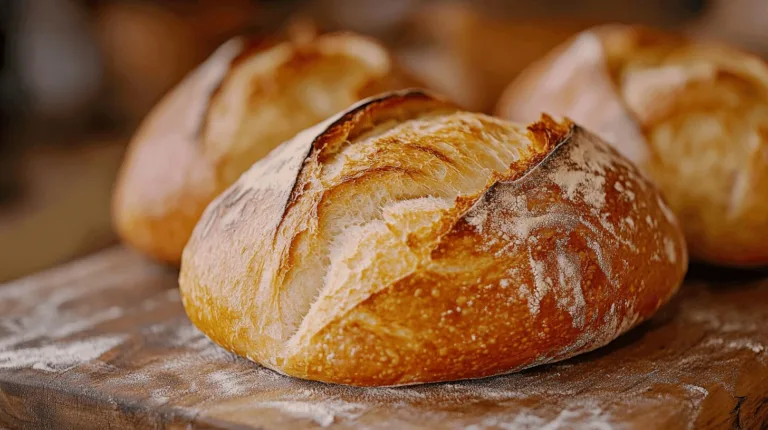
Cuban Bread Recipe: Easy Homemade Method for Perfectly Fluffy Bread
Cuban bread recipe is a traditional staple in Cuban cuisine, known for its crispy crust and soft, airy interior. This easy homemade Cuban bread is perfect for Cuban sandwiches (Cubanos), tostadas, or enjoying warm with butter and coffee. Follow this step-by-step recipe to make authentic bakery-style Cuban bread at home!
- Total Time: ~2 hours 45 minutes
- Yield: 2 loaves
Ingredients
✔ 4 cups bread flour (or all-purpose flour)
✔ 1 ½ cups warm water (about 100°F/38°C)
✔ 2 ¼ teaspoons (1 packet) active dry yeast
✔ 2 tablespoons sugar
✔ 1 ½ teaspoons salt
✔ 2 tablespoons lard (or unsalted butter, melted)
Instructions
1. Activate the Yeast
- In a small bowl, combine warm water, sugar, and yeast.
- Stir gently and let sit for 5–10 minutes until foamy.
2. Mix the Dough
- In a large mixing bowl, combine flour and salt.
- Add the yeast mixture and melted lard (or butter).
- Mix until a sticky dough forms.
3. Knead the Dough
- Transfer dough to a lightly floured surface and knead for 10–12 minutes.
- Dough should be smooth and elastic.
4. First Rise
- Place dough in a greased bowl and cover with a damp towel.
- Let rise in a warm place for 60–90 minutes, until doubled in size.
5. Shape the Loaves
- Punch down the dough and divide into two equal portions.
- Shape into long, oval loaves (about 12 inches long).
- Place on a parchment-lined baking sheet.
6. Second Rise
- Cover and let rise for 30 minutes.
7. Bake the Bread
- Preheat oven to 400°F (200°C).
- Place a shallow pan of hot water on the bottom rack for steam.
- Bake for 20–25 minutes, until golden brown.
8. Cool & Serve
- Let cool on a wire rack for 15 minutes before slicing.
- Serve fresh or store properly for later use.
Notes
- For a crispier crust: Spray the loaves with water before baking.
- For a vegetarian version: Replace lard with butter or vegetable shortening.
- To freeze: Wrap the cooled bread in plastic and store for up to 3 months.
- Best eaten within 24 hours for maximum freshness!
- Prep Time: 15 minutes
- First Rise Time: 90 minutes
- Cook Time: 90 minutes
- Category: Bread Recipes
- Method: Baking
- Cuisine: Cuban, Latin American
Nutrition
- Serving Size: 1 Slice, Approx. 50g
- Calories: 140 kcal
- Sugar: 1g
- Sodium: 190mg
- Fat: 2g
- Saturated Fat: 1g
- Unsaturated Fat: 1g
- Trans Fat: 0g
- Carbohydrates: 25g
- Fiber: 1g
- Protein: 4g
- Cholesterol: 2mg
Keywords: Cuban bread recipe, homemade Cuban bread, authentic Cuban bread, Cuban sandwich bread, easy Cuban bread

